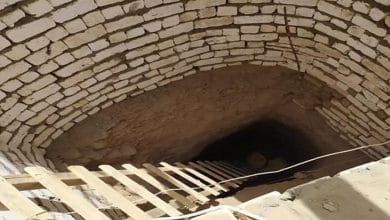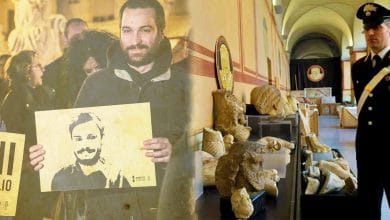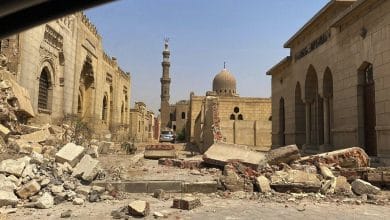
To start with, we can divide the Egyptian antiquities found abroad into two main types:
First, the Egyptian antiquities that were seized and smuggled abroad throughout our long history, from the era of the Romans to the modern era, where foreign countries have looted all the Egyptian antiquities that they liked and smuggled them outside the country. These antiquities are currently on display in various museums all over the world or scattered in the squares of international capitals, the number of which has been estimated according to accurate statistics to be at least one million artifacts[1]. According to international laws, these artifacts displayed in museums abroad are only defined as Egyptian antiquities, but meanwhile they belong to those museums that display them.
Second, the Egyptian antiquities that we regularly see and hear about while they are offered for sale at public auctions in the United States, Europe and others. This type of antiquities is not registered in international museums, as it is often unregistered in Egyptian museums; but it is easier to seek to recover it than the first type.
This report will address the issue of recovering Egyptian antiquities from abroad, via two main axes:
First: Reality of recovering Egyptian antiquities from abroad
Second: Suggestions for recovering Egyptian antiquities from abroad
First: Reality of recovering Egyptian antiquities from abroad
The government often rushes to announce its relentless pursuit of recovering Egyptian antiquities from abroad whenever reports about smuggling some of those antiquities abroad are circulated. But recently, when reports appeared about involvement of the former director of the Louvre Museum, Paris, in sale of Egyptian antiquities to the Abu Dhabi’s Louvre Museum and the New York-based Metropolitan Museum of Art, the Egyptian Ministry of Antiquities almost completely ignored the reports. To cover this up, it stated that Egypt succeeded in recovering 29,000 artifacts within 5 years[2]. Also, it was previously announced by the Supreme Council of Antiquities that the government succeeded during 2021 in recovering 115 artifacts from France, and 5,000 artifacts from the United States.[3]
The Minister of Tourism and Antiquities also announced that the government succeeded over recent years in recovering thousands of artifacts and coins from Italy, France, Spain, England, Germany, Switzerland, Belgium, the Netherlands, Austria, Denmark, Cyprus, Canada, Mexico, the United States, Lebanon, Jordan, Saudi Arabia, the United Arab Emirates, Kuwait, and others[4], which is considered sufficient evidence to show the extent of the looting and smuggling of Egyptian antiquities abroad.
The effort made by the Antiquities Repatriation Department is not at all commensurate with what it should really do. Also, the numbers of the artifacts that the department says it has been able to return in recent years indicate a clear fraud, as there are at least 21,000 small coins out of the 29,000 artifacts that the department has declared to have recovered. This number of small coins (21 thousand pieces) was among approximately 22 thousand artifacts that were seized in Italy after being smuggled in a diplomatic container from the port of Alexandria[5]. In addition, there are many other artifacts that have been recovered from abroad through the efforts of the anti-smuggling departments in the ports of foreign countries, rather than the efforts of the Antiquities Repatriation Department. For example, some 36 artifacts were returned from Spain after the authorities there seized them in the port of Valencia from Alexandria[6]. Also, other artifacts were returned by foreign countries without the intervention of the Egyptian government; such as the 425 Egyptian artifacts that have been donated by Sheikh Sultan bin Muhammad Al Qasimi, ruler of the UAE’s Sharjah Emirate[7], where these artifacts belong to several historical periods in Egypt’s history.
Although the Antiquities Repatriation Department has recurrently announced that it is closely following up foreign auctions, especially Egyptian antiquities that are sold there, and that it always seeks to stop the sale of these artifacts and recover them to the homeland, the London-based Christie’s auction house has recently managed to sell 14 Egyptian antiquities worth a total of nearly 8 million euros, including statues of Osiris, Horus, Amon and Anubis, in addition to a number of rare statues; including a stone statue of a sitting father, with his young son standing next to him, dating back to the Ancient Kingdom, 4400 years ago, where this statue alone was sold for more than 6 million euros – and it turned out that the antiquities repatriation department did not really know anything about the auction[8]; although after the sale was completed, the general supervisor of the Antiquities Repatriation Department stated that “there are procedures “currently” taking place regarding the Egyptian artifacts that were sold in that auction, and that the conclusion of the auction and the sale of antiquities should not cause any concern, because we are already following up the case, as we were following up the auction. even before it started. We have a complete portfolio on the artifacts that were auctioned, and we were not at all surprised by the auction,” he said[9].
It is known that Christie’s is a well-known and prestigious auction house, where it does not sell any artifacts without having its own identification documents, in accordance with requirements of international laws related to trafficking in antiquities and artifacts. For example, the ownership documents of the statue of the seated father and his young son standing next to him, found at Christie’s, show that it belonged to a British diplomat, James Porter, who was British Ambassador to the Ottoman Empire during the period 1746-1762, and that the diplomat gave the statue to the British King George III as a gift, who then donated it to Thomas Worsley, an English clergyman, who has kept the statue since then in his palace in Hoffenheim Hall, United Kingdom[10].
However, sometimes the identification documents of artifacts are incorrect, which often happens, such as the fraud that occurred in the documents related to sale of Egyptian antiquities in recent years and even months to the Metropolitan Museum of Art based in New York and the Louvre Museum, based in Paris. The former director of the Louvre Museum, Jean-Luc Martins, was accused of conspiring to conceal the origin of antiquities stolen from Egypt after 2011, and helping to sell them to the Abu Dhabi Louvre Museum in 2016 for millions of euros[11]. The Public Prosecution Office in New York also seized five Egyptian artifacts that were in the possession of the Metropolitan Museum, most likely stolen, including a drawing of a woman’s face dating back to between 54 and 68 AD, at a value of about one million and two hundred thousand dollars. Also, the US prosecution announced that this step falls within the “same investigation” launched by France against the former director of the Paris-based Louvre Museum. The Metropolitan Museum confirmed that it had already purchased the five artifacts between 2013 and 2015, but considered itself to have fallen victim to an organized global criminal gang[12].
In fact, the French-American investigation expanded regarding the stolen Egyptian artifacts, to include the golden coffin of the Ancient Egyptian Priest Nedjemankh, which was on display at the Metropolitan Museum in New York in 2017, as it was smuggled illegally after the January 2011 revolution, via a sea container to Dubai, UAE, where it was exported with a forged invoice to Germany, through France and up to the United States. By examining the export certificate submitted to the French Ministry of Industry and Trade, it was discovered that it was forged, as the stamps affixed to it did not correspond to those used by the Egyptian authorities during the concerned period. Then, the American authorities confiscated the sarcophagus in February 2019 and returned it to Egypt[13].
Egypt’s success in recovering this sarcophagus is one of the most prominent successes[14], where Egypt had questioned the coffin’s ownership documents, and filed lawsuits with the Supreme Court in Manhattan, New York, in this regard, until the American court ruled that Egypt had the right to retrieve it. The sarcophagus, which is two meters long, covered with gold plates, belonged to the Ancient Egyptian Priest Nedjemankh in the first century BC, buried in Minya, Upper Egypt[15].
In 2019, 20 Egyptian artifacts were sold at Christie’s in London as well, including a brown quartz stone statue in the form of Tutankhamun’s head, 28.5 centimeters high. It was sold for nearly $6 million, despite Cairo’s objection at the time to the sale process and its demands from London and the UNESCO to stop the sale; and it also addressed Christie’s to review the related documents[16], but Christie’s confirmed that it had conducted in-depth audits to verify the source of the artifact and its legal status, stating that: “the said artifact is not subject of investigation, was not at any time in the past, and it did not raise any concerns about it. although its existence has been widely known[17].
This is the reality of the process of recovering Egyptian antiquities from abroad, which is a frightening reality, where international museums are adorned with Egyptian antiquities, and international auctions for the sale of Egyptian antiquities do not stop. The seizure of Egyptian antiquities in the ports and airports of foreign countries after passing through Egyptian ports and airports is also expanding, which is a shameful matter. Despite all this, the Antiquities Repatriation Department affiliated with the Supreme Council of Antiquities from time to time announces that it has retrieved thousands of artifacts!!
Second: Suggestions for recovering Egyptian antiquities from abroad
According to the above division related to Egyptian antiquities abroad, the possibility of recovering them differs according to each type separately, as follows:
For the first type, that is the Egyptian antiquities that were seized and smuggled abroad throughout Egypt’s long history, and are currently displayed in various museums of the world: these artifacts, according to international laws – as mentioned above – are only defined as Egyptian antiquities, but in fact they belong to those museums and countries.
It is not logical to demand the return of all these Egyptian artifacts now, after decades and even centuries of smuggling them to different countries of the world, where some international museums were specifically built to display Egyptian antiquities, and it is not reasonable to close them. However, Egypt can do the following:
– Demand those museums to return unique artifacts, such as the Rosetta Stone displayed in the London Museum, and the head of Nefertiti displayed in the Berlin Museum.
– Demand international museums to return the replicas of Egyptian antiquities displayed in those museums to Egypt.
– Seek having a supervisory authority in museums that contain Egyptian antiquities, in order to follow up on them, and to ensure that they are well secured.
– Take advantage of emergency events, where foreign museums containing Egyptian antiquities are exposed to damage, such as damage resulting from wars, fires, or deliberate distortion by extremists and miscreants, and to demand participation with those museums in securing and preserving Egyptian antiquities.
– Concluding understandings regarding obtaining a percentage of the revenues generated by the tourism activities related to those antiquities.
As for the second type, that is the Egyptian antiquities that we regularly see and hear about while they are offered for sale at public auctions in the United States, Europe and others, or those artifacts that were seized in foreign countries after being smuggled out of Egypt – where these antiquities are neither registered in international museums, nor in Egyptian museums: this type is easier to work on, with respect to recovering the antiquities, than the first type, although the matter varies from case to case, as follows:
– If the antiquities displayed in those auctions or seized in foreign countries during or after the smuggling process, were registered in the records of the Egyptian Ministry of Antiquities and well documented, in this case it is very easy for the Egyptian authorities to work on recovering them once it is proven that they are registered in their records.
– If the artifacts were not registered within the Egyptian antiquities records, but Egyptian authorities were able to prove that they were smuggled out of Egypt illegally, then in this case, Egypt can also recover them, using legal and diplomatic means.
– In the event that the artifacts offered for sale in international auctions, or seized during and after the smuggling process in foreign countries, are Egyptian in form and content, but the Egyptian authorities were unable to prove that they were smuggled out of Egypt illegally, then according to the international laws on heritage protection, we cannot work to recover them, which often happens unfortunately.
In fact, there are Egyptian antiquities offered for sale at auctions, where they have mainly existed outside Egypt for decades, and even for centuries, and these artifacts were not included by international museums because they were either in the private collections of some looters of Egypt’s antiquities, or were acquired by people and families for generations until they finally decided to sell.
In order for Egyptian antiquities not to fall under this last type, authorities should work on:
– Forming a national committee to recover Egypt’s antiquities, where such committee would be granted all required human competencies and scientific, financial, legal and diplomatic capabilities that would make it able to achieve its goal. It would be better if this suggested committee start its work by organizing a national campaign to restore Egyptian antiquities abroad.
– Raising awareness of the importance of Egyptian antiquities and the Egyptian heritage and the need to preserve it, using all media, cultural, educational means, and others.
– Expediting the work of making a scientific and accurate inventory of all artifacts lost from antiquities stores and museums, taking into mind that it is not enough to mention a fictitious number of the lost items without clearly identifying those artifacts in terms of shape and description, the place from which they were lost and the date of their loss, so that the Antiquities Repatriation Department can work on tracking them, and seek recovering them as soon as they appear in any international exhibition or auction.
– Following up on auctions and foreign exhibitions that display Egyptian antiquities, before they start, especially since auction houses announce their exhibitions before they open. Egypt can track this in all countries through Egyptian diplomatic missions deployed all over the world.
– Eliminating causes of smuggling Egyptian antiquities abroad, by eliminating illegal excavations of antiquities by citizens, trading in them, and consequently smuggling them abroad.
– Imposing a tight control on the Egyptian land, sea and air ports, so that no one can smuggle any antiquities outside the country.
– Enacting domestic legislation to prevent, prohibit and punish anyone who attempts to smuggle Egyptian antiquities abroad, whether citizens or officials, given that Law 117 of 1983 regarding the protection of antiquities and its amendments, still contains loopholes that allow smuggling operations.
– Monitoring the work of foreign missions, and ensuring that their members do not smuggle any artifacts while leaving the country after completing their seasonal work.
– Seeking to amend international agreements and laws related to the preservation of heritage, as they are not sufficient to preserve antiquities and ban selling them in international markets. For example, the 1970 UNESCO Convention on the Means of Prohibiting and Preventing the Illicit Import, Export and Transfer of Ownership of Cultural Property cannot help recovering Egyptian antiquities smuggled outside the country prior to the date of its (the Convention) entry into force in 1972.
Despite this, the 1972 UNESCO Convention includes many provisions that can be used to recover some of Egyptian antiquities that were unofficially released after that date. For, example, Article VII urged Member States and even obligated them to take all necessary measures to prevent museums and similar institutions located in their territories from acquiring cultural property from another state party to the Convention; and it prohibited the import of stolen cultural property from a museum or an archaeological building, provided that such property is included in the inventory list of the said institution.
Article VII stipulated: “The States Parties to this Convention undertake: To take the necessary measures, consistent with national legislation, to prevent museums and similar institutions within their territories from acquiring cultural property originating in another State Party which has been illegally exported after entry into force of this Convention, in the States concerned. Whenever possible, to inform a State of origin Party to this Convention of an offer of such cultural property illegally removed from that State after the entry into force of this Convention in both States; 1) to prohibit the import of cultural property stolen from a museum or a religious or secular public monument or similar institution in another State Party to this Convention after the entry into force of this Convention for the States concerned, provided that such property is documented as appertaining to the inventory of that institution; 2) at the request of the State Party of origin, to take appropriate steps to recover and return any such cultural property imported after the entry into force of this Convention in both States concerned, provided, however, that the requesting State shall pay just compensation to an innocent purchaser or to a person who has valid title to that property. Requests for recovery and return shall be made through diplomatic offices. The requesting Party shall furnish, at its expense, the documentation and other evidence necessary to establish its claim for recovery and return. The Parties shall impose no customs duties or other charges upon cultural property returned pursuant to this Article. All expenses incident to the return and delivery of the cultural property shall be borne by the requesting Party.”
Also, Article IX stated that the states parties should cooperate with each other to work on recovering the looted antiquities. It stipulated: “Any State Party to this Convention whose cultural patrimony is in jeopardy from pillage of archaeological or ethnological materials may call upon other States Parties who are affected. The States Parties to this Convention undertake, in these circumstances, to participate in a concerted international effort to determine and to carry out the necessary concrete measures, including the control of exports and imports and international commerce in the specific materials concerned. Pending agreement each State concerned shall take provisional measures to the extent feasible to prevent irremediable injury to the cultural heritage of the requesting State.”
Article X explicitly put a limit on how to monitor and follow up on international auctions, and limit their activities, as it obligated the signatory countries to work to limit the movement of cultural property by illegal means, and obligated antiquities dealers, to keep a record to prove the origin of each cultural property, name and address of the supplier, and description and price of each item sold. It stipulates: “The States Parties to this Convention undertake: 1) To restrict by education, information and vigilance, movement of cultural property illegally removed from any State Party to this Convention and, as appropriate for each country, oblige antique dealers, subject to penal or administrative sanctions, to maintain a register recording the origin of each item of cultural property, names and addresses of the supplier, description and price of each item sold and to inform the purchaser of the cultural property of the export prohibition to which such property may be subject; 2) To endeavor by educational means to create and develop in the public mind a realization of the value of cultural property and the threat to the cultural heritage created by theft, clandestine excavations and illicit exports.”
Article XI of the 1970 UNESCO Convention on the Means of Prohibiting and Preventing the Illicit Import, Export and Transfer of Ownership of Cultural Property explicitly states that it is considered an illegal act to export cultural property and forcibly transfer its ownership, as a direct or indirect result of a foreign country’s occupation of another country (taking into mind that Egypt was officially under British occupation until 18 June 1956). Article XI stipulates: “The export and transfer of ownership of cultural property under compulsion arising directly or indirectly from the occupation of a country by a foreign power shall be regarded as illicit.”[18]
Footnotes
[1] The Egyptian Institute for Studies, “Where are the smuggled Egyptian antiquities? When and how were they smuggled? Are they likely to return?, 27 November 2020, link.
[2] Sada El Balad, “Egypt succeeds in recovering 29,000 artifacts within 5 years, 16 June 2022, link.
[3] Shorouk News, “Ministry of Antiquities: We recovered 29,000 artifacts during the last period”, 5 June 2022, link.
[4] Alakhbar Almsaey, Egypt recovers 29,000 artifacts within 7 years, 14 June 2022, link.
[5] El-Watan, “The story of ‘major antiquities smuggling case’”… 21 thousand artifacts found and a former Italian consul sentenced to imprisonment, 21 January 2020, link.
[6] The Independent Arabia, Egypt recovers 36 artifacts smuggled to Spain, 21 December 2021, link.
[7] Sky News, UAE presents Egypt with hundreds of rare artifacts, 6 January 2020, link
[8] Al-Araby TV, Egyptian antiquities sold once again at the British Christie’s… Can they be recovered?, 15 July 2022, link.
[9] Akhbarelyom, “Director of Recovered Antiquities: We are following up Christie’s auction and we have a complete file of the sold items, 17 July 2022, link.
[10] El-Saha, “Details of the sale of 14 Egyptian artifacts in two days, 14 July 2022, link.
[11] Masrawy, “Former director of the Louvre Museum…from a protector of antiquities to being accused of smuggling 5 Egyptian artifacts, 5 June 2022, link.
[12] Arabic EuroNews, “Egyptian Artifacts confiscated from the Metropolitan Museum in New York as part of a French investigation into antiquities smuggling, 3 June 2022, link.
[13] Shorouk News, “Including a golden sarcophagus of Priest Nedjemankh.. the most important artifacts in France’s investigations into the antiquities smuggling case, 28 May 2022, link.
[14] Youm7, Egypt hosts the first regional conference on “Combating Money Laundering and Terrorism Funding”, 14 June 2022, link.
[15] Akhbarelyom, “Nedjemankh” .. The story of the sarcophagus of an “ancient Egyptian priest” that Egypt succeeded in recovering from US, 30 September 2019, link.
[16] Anadolu Agency, “Egypt addresses Britain to stop the auction of the head of the “Golden Pharaoh”, 10 June 2019, link.
[17] Annahar, “Tutankhamun’s Head” sculpture, sold for six million dollars, despite Egypt’s opposition, 5 July 2019, link.
[18] The views expressed in this article are entirely those of the author’s and do not necessarily reflect the views of the Egyptian Institute for Studies
To Read Text in PDF Format Click here.



